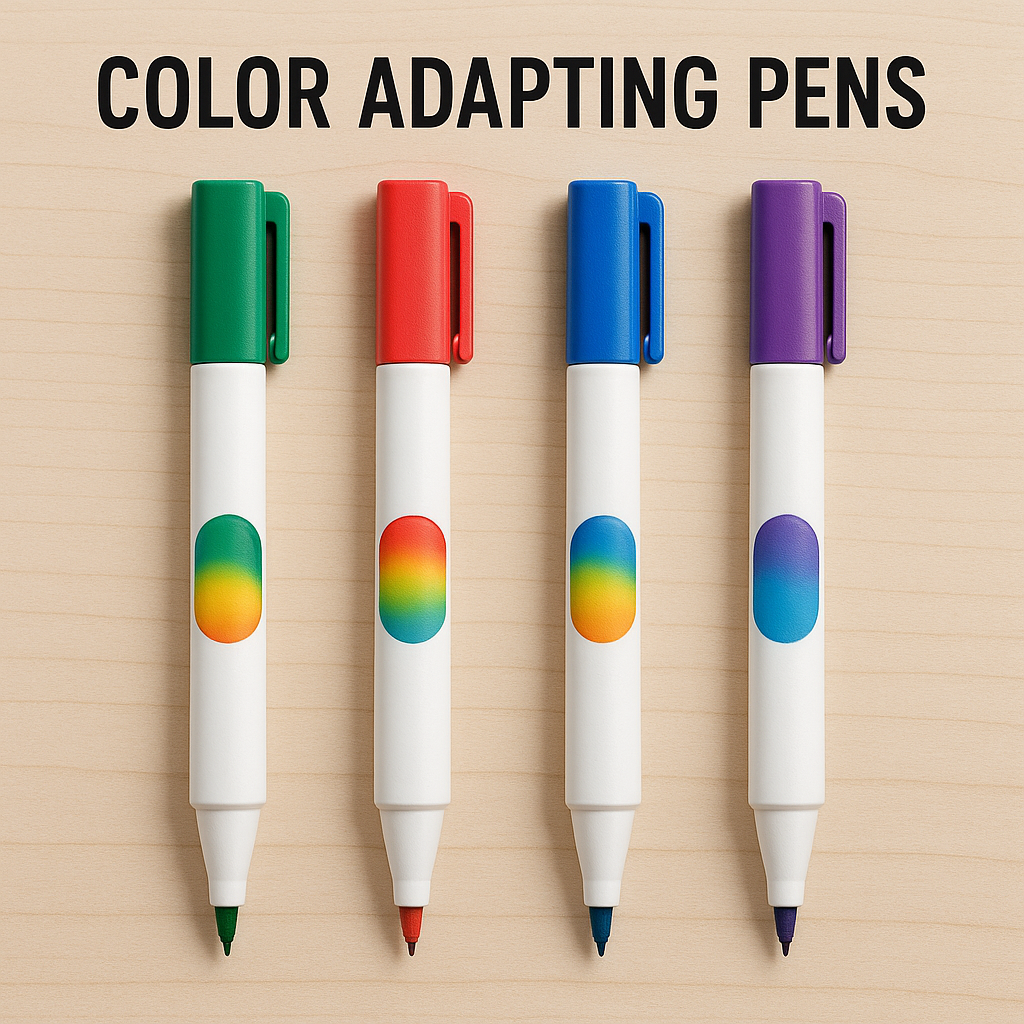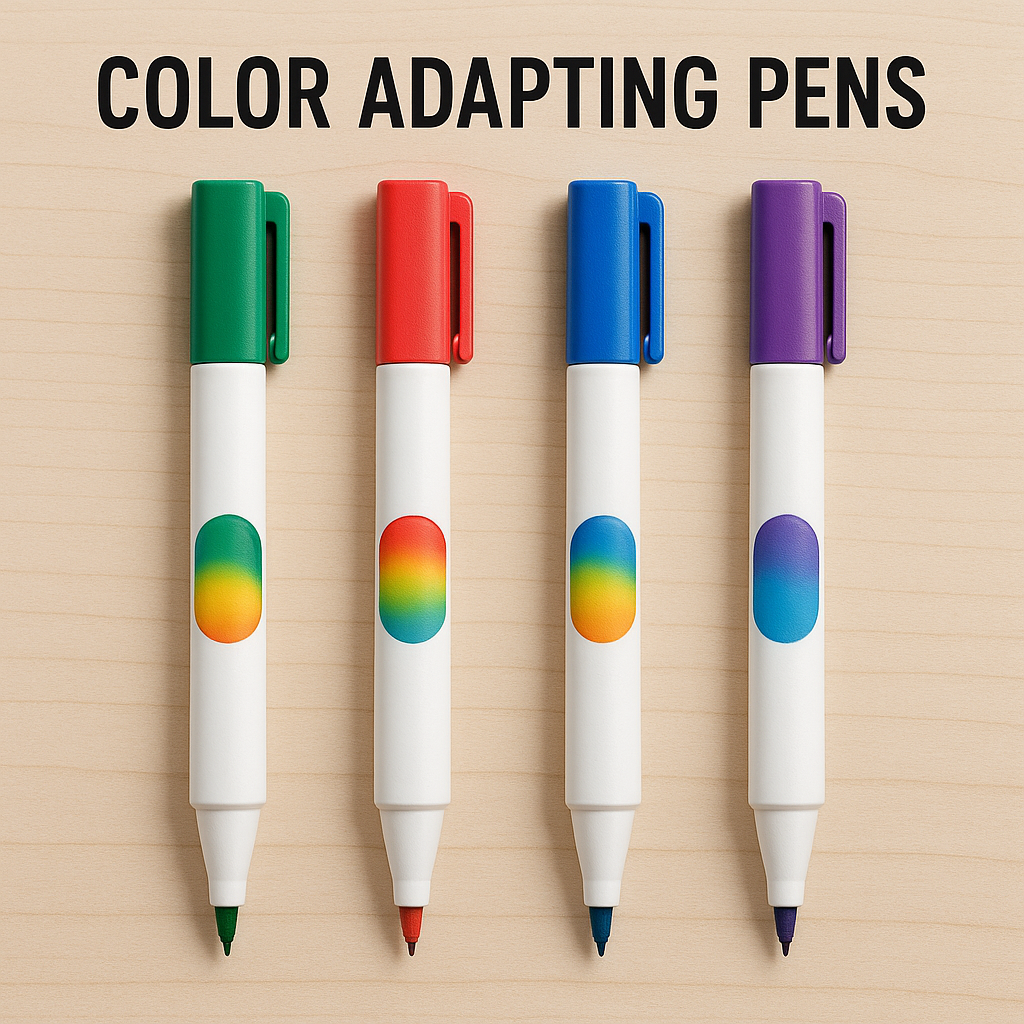
Have you ever wished you could replicate the exact color of a flower petal or a sunset with just a pen? Or watched in awe as ink transformed from blue to pink before your eyes? In the ever-evolving world of art tools, two technologies stand out: color adapting pens and color changing pens. While they may sound similar, they operate on entirely different principles.
Let’s dive into what makes each unique, how they work, and what artists, writers, and tech lovers can expect from these color-centric innovations.

Find multi Color Pens
What is a Color Adapting Pen?
A color adapting pen, sometimes called a color replicating or color-picking pen, is an advanced writing instrument capable of scanning colors from the real world and reproducing them as ink.
How it Works: The Science Behind the Magic
Think of a color adapting pen as a combination of a scanner, a computer, and a printer, all housed within a handheld device.
| Component | Function |
|---|---|
| Color Sensor | Captures the RGB or RGBC values of a color from a surface |
| Microprocessor | Processes the scanned color data |
| CMYK Ink Cartridges | Contain base inks (Cyan, Magenta, Yellow, Black – and sometimes White) that are mixed to replicate the scanned color |
| Mixing Chamber | Blends the inks to create the target shade |
| Dispensing Nib | Outputs the custom color ink for writing or drawing |
Real Example: Colorpik Pen (formerly Scribble Pen)
- Color Sensor: Reads color from real-world surfaces
- Ink Mixing: Custom mixes the required shade on demand
- Output: Writes in the exact scanned color
- Bonus: Often includes a stylus for transferring color to digital screens
This pen is ideal for designers, illustrators, architects, and artists who need on-the-go color matching.

Find multi Color Pens
Does the Ink Change with Time?
No, the ink does not change color over time. Once the color is created and applied, it behaves like any other high-quality ink: stable and permanent under normal conditions.
However, as with all inks, long-term exposure to UV light or air may cause gradual fading over the years.
What is a Color Changing Pen?
Color changing pens are not about capturing color from the environment but about transforming the color of ink through chemical reactions or environmental stimuli like temperature or light.
How They Work: A Chemistry Experiment on Paper
| Type | Mechanism | Description |
|---|---|---|
| pH-sensitive | Acid-base reaction | Ink changes color when it reacts with a “changer” pen or another chemical agent |
| Thermochromatic | Temperature-sensitive | Ink changes color based on heat (e.g., disappears with friction) |
| Photochromatic | Light-sensitive | Ink changes in response to UV light exposure |
Example 1: Magic Pens (pH Sensitive)
- Ink A (e.g., Blue): Contains pH-sensitive dyes
- Ink B (Clear Overwriter): Alters pH on contact
- Reaction: Blue turns to Pink when overlaid with the overwriter
These are common in children’s art kits and used for fun, creative experiments and secret writing.
Example 2: Thermochromic Pens
- Often used in erasable pens like Pilot Frixion
- Ink disappears when heated via friction (e.g., rubber eraser)
- Reappears in freezing conditions
Example 3: Photochromatic Ink
- Found in novelty pens or promotional items
- Ink changes in the sun (e.g., white ink turning blue outdoors)
Does the Ink Change Over Time?
It depends on the stimulus:
- pH Reaction: Permanent change, unless chemically reversed
- Thermochromic Ink: Reversible with temperature
- Photochromatic Ink: Reversible with light exposure
However, with repeated use or prolonged exposure, the color-changing effects may degrade over time.

Find multi Color Pens
Color Adapting vs Color Changing Pens: Key Differences
| Feature | Color Adapting Pen | Color Changing Pen |
|---|---|---|
| Function | Replicates colors from the environment | Ink color transforms based on stimuli |
| Technology | Color sensors, ink mixing system | Chemical dyes and reaction-based changes |
| Control | User controls the color by scanning | User triggers a change via stimulus (heat, light, pH) |
| Stability | Ink remains stable once applied | Ink may revert or fade depending on stimulus |
| Applications | Design, art, industrial use | Children’s toys, novelty, craft effects |
Real-World Applications
For Color Adapting Pens:
- Product Designers: Match packaging colors instantly
- Interior Designers: Scan colors from fabrics, furniture, or paints
- Artists & Illustrators: Replicate real-world shades without carrying dozens of markers
- Teachers: Demonstrate color theory in a fun, interactive way
For Color Changing Pens:
- Educational Kits: Teach kids chemistry through interactive writing
- Security Marking: Inks that appear/disappear with temperature
- Craft Projects: Dynamic cards or posters that respond to light
- Fun & Games: Hidden messages, secret writing, and more
Are These Pens Readily Available?
| Pen Type | Popular Models | Availability | Price Range |
|---|---|---|---|
| Color Adapting | Colorpik Pen, Future potential from brands like Apple or Wacom | Limited (pre-order or crowdfunding) | $100–$300+ |
| Color Changing | Pilot Frixion, Crayola Magic Marker Sets | Widely available | $5–$30 |
Color adapting pens are still in the early stages of mass production, while color changing pens are commonly found in stores and online.
Limitations to Consider
Color Adapting Pens:
- Cost: More expensive due to advanced technology
- Battery/Charging: Electronic components require power
- Ink Refills: May need special cartridges
- Accuracy: Matching is close, but not 100% perfect for every surface
Color Changing Pens:
- Longevity: Effects may degrade over time
- Color Limitations: Limited to preset chemical behaviors
- Reversibility: Some effects (like thermochromism) are reversible, which may not be ideal for permanence

Find multi Color Pens
Future of Color Technology in Pens
As material science and microelectronics evolve, we may soon see pens that:
- Autonomously switch between thousands of shades on command
- Connect with digital design platforms to sync physical-digital colors
- Combine adaptive and changing technologies for interactive learning or AR-linked drawing
Imagine a pen that captures a color, writes in it, and then changes hue depending on mood, light, or even time of day — the creative possibilities are endless!
Final Thoughts
The phrase “color adapting pen” might sound futuristic, but it’s already here in limited form — and it’s redefining how we interact with color.
- If you’re after precision and realism, go for a color adapting pen.
- If you’re into fun, magic, and interactive creativity, a color changing pen might be your style.
No matter the choice, these pens aren’t just tools — they’re gateways to a more vibrant, expressive world.
Ready to write in the color of your imagination? The rainbow is now literally at your fingertips.
Affiliate Disclosure
This post may contain affiliate links. If you purchase through these links, I may earn a small commission at no extra cost to you. I only recommend products I personally use or thoroughly research. Thank you for supporting this blog—it helps me continue creating helpful content for fellow creators and enthusiasts.
About Me
Hi, I’m Sujith—a content creator, photography enthusiast, and eCommerce expert. I have a passion for discovering creative tools and gadgets that spark inspiration. Whether it’s testing pens that adapt to color, exploring the latest AI art tools, or reviewing must-have gear for creators, I’m here to share honest insights to help you make smart buying decisions. When I’m not blogging, you’ll find me behind the camera or experimenting with digital design. Thanks for stopping by!
FAQs
Q: Do color adapting pens work on all surfaces?
A: Most are designed for standard paper. Performance may vary on glossy or textured surfaces.
Q: Can I refill the ink in a color adapting pen?
A: Yes, but usually with proprietary cartridges.
Q: Are color changing pens safe for kids?
A: Yes. Most use non-toxic, child-safe dyes.
Q: Can thermochromic ink be erased permanently?
A: The ink disappears with heat but can reappear in cold unless exposed to high temperatures (like ironing) for permanent removal.
Q: Are there pens that combine both color adapting and color changing features?
A: Currently, no major brand offers both in a single device, but future innovations may make this possible.